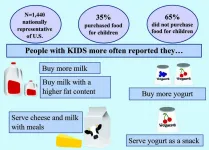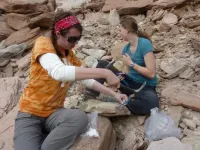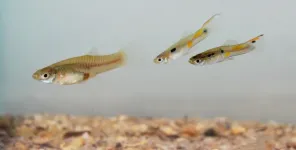(Press-News.org) PHILADELPHIA - Our biological or circadian clock synchronizes all our bodily processes to the natural rhythms of light and dark. It's no wonder then that disrupting the clock can wreak havoc on our body. In fact, studies have shown that when circadian rhythms are disturbed through sleep deprivation, jet lag, or shift work, there is an increased incidence of some cancers including prostate cancer, which is the second leading cause of cancer death for men in the U.S. With an urgent need to develop novel therapeutic targets for prostate cancer, researchers at the Sidney Kimmel Cancer - Jefferson Health (SKCC) explored the circadian clock and found an unexpected role for the clock gene CRY-1 in cancer progression. The study was published on January 15th in Nature Communications.
"When we analyzed human cancer data, the circadian factor CRY-1 was found to increase in late stage prostate cancers, and is strongly associated with poor outcomes," explains Karen Knudsen, MBA PhD, executive vice president of oncology services for Jefferson Health and enterprise director of SKCC, and senior author of the study. "However, the role CRY-1 in human cancers has not been explored."
A common therapy for prostate cancer involves suppressing the male hormone androgen and/or the androgen receptor, as prostate tumors require androgens to develop and progress to advanced disease. With their collaborators in the U.S. and Europe, the researchers found that CRY-1 is induced by the androgen receptor in prostate tumor tissue obtained from patients, thus explaining in part the high levels of CRY-1 observed in human disease.
"This was a clear indication of CRY-1's link to prostate cancer," says Ayesha Shafi, PhD, a postdoctoral researcher in Dr. Knudsen's lab and first author of the study. "As we looked further into the role of CRY1, we unexpectedly found that the circadian factor was altering the way that cancer cells repair DNA."
Cancer treatments aim to damage the DNA in cancer cells and cause defects in repair mechanisms; eventually the cells self-destruct when the damage is severe. The researchers probed CRY-1's possible role in DNA repair in cultured cells, animal models and tissue harvested from prostate cancer patients. They first induced DNA damage by exposing cancer cells to radiation and found that CRY-1 levels became elevated, indicating that it was responding to this type of damage. They also found that CRY-1 directly regulates the availability of factors essential for the DNA repair process, and alters the means by which cancer cells respond to DNA damage. The findings suggest that CRY-1 may offer a protective effect against damaging therapies.
"The fact that CRY-1 is elevated in late-stage prostate cancer may explain why androgen-targeting treatments become ineffective at those later stages," says Dr. Shafi. "It also tells us that if a tumor has high levels of CRY-1, DNA repair targeting treatments may be less effective for them."
"Not only have we outlined a role for CRY-1 outside of its canonical function in circadian rhythms, Dr. Shafi's findings are the first to reveal the means by which CRY1 contributes to aggressive disease," adds Dr. Knudsen. "It's notable that the pro-tumor functions of CRY1 may be viable targets to treat prostate cancer, and this is a direction that Dr. Shafi's future work will explore."
Looking ahead, the team plans to explore how best to target and block CRY-1 and what other existing therapies may work synergistically to hinder DNA repair in prostate cancer cells. They also plan to study more circadian rhythm genes and determine how circadian disruption may affect cancer treatment.
"It's been shown that circadian disruptions can affect efficacy of treatment, but also that aligning treatment with the body's natural rhythms or giving therapy at certain times of the day can be beneficial," explains Dr. Knudsen. "Our findings open up a multitude of important research questions exploring the link between the circadian clock and cancer."
INFORMATION:
This work was supported by a Young Investigator Award and Challenge Award from the Prostate Cancer Foundation to Dr. Shafi and Dr. Knudsen respectively, NCI grant F99CA212225, NCI R01-CA182569, The KWF Dutch Cancer Society, SKCC Support Grant (5P30CA056036). Drs. Shafi and Knudsen thank lead collaborators and their research groups - Dr. Felix Feng, Dr. Michael Brunner, and Dr. Wilbert Zwart. The authors report no conflict of interest.
Article Reference: Ayesha A. Shafi, Chris M. McNair, Jennifer J. McCann, Mohammed Alshalalfa, Anton Shostak, Tesa M. Severson, Yanyun Zhu, Andre Bergman, Nicolas Gordon, Amy C. Mandigo, Saswati N. Chand, Peter Gallagher, Emanuela Dylgjeri, Talya S. Laufer, Irina A. Vasilevskaya, Matthew J. Schiewer, Michael Brunner, Felix Y. Feng, Wilbert Zwart, and Karen E. Knudsen, "The circadian cryptochrome, CRY1, is a pro-tumorigenic factor that rhythmically modulates DNA repair," DOI: 10.1038/s41467-020-20513-5, Nature Communications, 2020
Media Contact: Karuna Meda, 267-624-4792, karuna.meda@jefferson.edu.
Oxygen levels in the ancient oceans were surprisingly resilient to climate change, new research suggests.
Scientists used geological samples to estimate ocean oxygen during a period of global warming 56 million years ago - and found "limited expansion" of seafloor anoxia (absence of oxygen).
Global warming - both past and present - depletes ocean oxygen, but the new study suggests warming of 5°C in the Paleocene Eocene Thermal Maximum (PETM) led to anoxia covering no more than 2% of the global seafloor.
However, conditions are different today to the PETM - today's rate of carbon emissions is much faster, and we are adding nutrient pollution to the oceans - both of which could drive more rapid and expansive oxygen loss.
The study was carried out by an international ...
Champaign, IL, January 15, 2021 - American dairy consumers are often influenced by a variety of factors that can affect their buying habits. These factors include taste, preference, government information, cultural background, social media, and the news. In an article appearing in JDS Communications, researchers found that households that frequently bought food for children are interested in dairy as part of their diet and purchased larger quantities of fluid milk and more fluid milk with a higher fat content.
To assess the purchasing habits of households that purchase food for children versus those ...
Families are complicated. For members of the Alligatoridae family, which includes living caimans and alligators - this is especially true. They are closely related, but because of their similarity, their identification can even stump paleontologists.
But after the recent discovery of a partial skull, the caimans of years past may provide some clarity into the complex, and incomplete, history of its relatives and their movements across time and space.
Michelle Stocker, an assistant professor of vertebrate paleontology in Virginia Tech's Department of Geosciences in the College of Science; Chris Kirk, of the University of Texas at Austin; and Christopher Brochu, of the University of Iowa, have ...
Researchers from University of Stavanger, University of Melbourne, and University of Wisconsin-Madison published a new paper in the Journal of Marketing that examines how major projects undertaken by temporary organizations can be better managed so that cost overruns are minimized.
The study forthcoming in the Journal of Marketing is titled "Mobilizing the Temporary Organization: The Governance Roles of Selection and Pricing" and is authored by Elham Ghazimatin, Erik Mooi, and Jan Heide.
When consumers return to the skies again, they may do so in Boeing's 787 Dreamliner. But the project, or "temporary organization," created to make this plane ...
Just like humans trying to stick to New Year's resolutions, guppies have varying levels of self-control, a new study shows.
Researchers from the University of Exeter and Ghent University studying the behaviours of Trinidadian guppies tested "inhibitory control" (suppressing unhelpful impulses or urges).
The tiny fish first learned how to swim into a cylinder to get food - then a cover was removed to make the cylinder transparent.
Inhibitory control was measured by whether a guppy resisted the urge to swim directly towards the food - bumping into the cylinder - or still swam around, ...
Researchers have developed a DNA test to quickly identify secondary infections in COVID-19 patients, who have double the risk of developing pneumonia while on ventilation than non-COVID-19 patients.
For patients with the most severe forms of COVID-19, mechanical ventilation is often the only way to keep them alive, as doctors use anti-inflammatory therapies to treat their inflamed lungs. However, these patients are susceptible to further infections from bacteria and fungi that they may acquire while in hospital - so called 'ventilator-associated pneumonia'.
Now, a team of scientists ...
Former director of public health Professor John Ashton has said that scientific scepticism may be reinforced by the UK's rush to approve COVID vaccines for public use and the apparent political desire to be the first out of the blocks in contrast to our European neighbours.
Writing in the Journal of the Royal Society of Medicine, Prof Ashton says that to risk the trust of the public for the sake of a couple of weeks propaganda advantage could prove to be unforgivable should vaccine uptake fall below that required for the ubiquitous 'herd immunity' as a result of giving oxygen to the sceptics.
"In this age of scientific rationality, superstition and anti-science still run deep," he writes. "When an overwhelming majority of the public welcomes the arrival of ...
BOSTON - Studies with a popular laboratory model, the nematode Caenorhabditis elegans, have revealed a possible therapeutic avenue for a rare but deadly condition in which children are born without the ability to make molybdenum cofactor (Moco) on their own.
Though little known, Moco is essential for life and so far it has proven extremely difficult to stably isolate this compound in the laboratory, preventing its use as a therapeutic supplement. This new work, which appears in Genes & Development, reveals that nematodes genetically engineered to be Moco-deficient can take up Moco that is attached to several types of proteins. This suggests that such protein-Moco complexes could be used as a treatment ...
In a normal year, biologists Daniel Janzen and Winnie Hallwachs spend about six months in Costa Rica, where they conduct research and pursue conservation efforts in Área de Conservación Guanacaste (ACG), a World Heritage Site in the northwest that encompasses, a network of parks and preserves they helped establish in the 1980s and that has grown to more than 400,000 acres, including marine, dry forest, cloud forest, and rain forest environments.
In 2020 that is where the married couple was when the COVID-19 pandemic took hold of the world, and compelled them to extend their stay in the virus-free forest until the fall, when they felt safe enough to travel back to their other home in Philadelphia.
"With modern laptops and internet, we could watch the world go ...
Anthropologist Caleb Everett and former student Sihan Chen used a novel data analysis of thousands of languages, in addition to studying a unique subset of celebrities, to reveal how a soft food diet--contrasted with the diet of hunter-gatherers--is restructuring dentition and changing how people speak.
Their findings, published in Scientific Reports, counter the longstanding belief within the field that maintains that languages are susceptible to the same pressures and so are essentially immune to external factors.
"Our results represent the most compelling evidence to date that languages are very much affected by external ...


